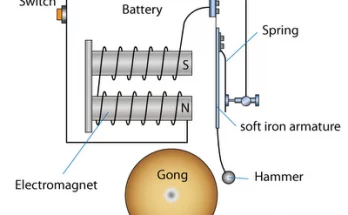Table of Contents
NCERT Exemplar Class 7 Science Chapter- 14 -Electric Current and Its Effects(Solutions with Explanation)
1. When an electric current flows through a copper wire AB as shown in Figure 14.1, the wire
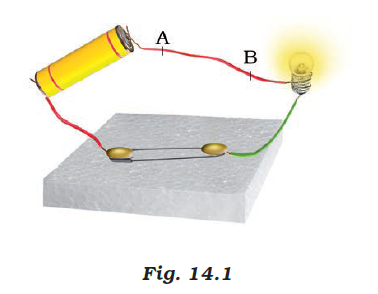
(a) deflects a magnetic needle placed near it.
(b) becomes red hot.
(c) gives an electric shock.
(d) behaves like a fuse.
Answer- (a) deflects a magnetic needle placed near it.
Explanation- A wire carrying electric current generates a magnetic field around it, essentially acting like a magnet. This magnetic field influences nearby magnetic objects, such as a compass needle. Hence, when a magnetic needle is placed near the current-carrying copper wire AB, it experiences a deflection due to the wire’s magnetic field. The extent of this deflection is influenced by the strength of the current flowing through the wire.
Also Check- Chapter 10 – Electric Current and its Effects – 5 Worksheets Solved and Unsolved
2. Choose the statement which is not correct in the case of an electric fuse.
(a) Fuses are inserted in electric circuits of all buildings.
(b) There is a maximum limit on the current which can safely flow through the electric circuits.
(c) There is a minimum limit on the current which can safely flow in the electric circuits.
(d) If a proper fuse is inserted in a circuit it will blow off if current exceeds the safe limit.
Answer- (c) There is a minimum limit on the current which can safely flow in the electric circuits.
Explanation- The incorrect statement is option (c). Electric fuses are designed to specify a maximum limit of current that can safely flow through an electric circuit, not a minimum limit. If the current exceeds this maximum safe limit, the fuse wire melts, interrupting the circuit to prevent potential damage or fire hazards. The purpose of a fuse is to protect electrical circuits from overcurrent, not to guarantee a minimum current flow. Options (a), (b), and (d) are correct descriptions of the function and purpose of fuses in electrical circuits.
Also Check- Rapid Revision – Class 7 Science- Chapter 14 – Electric Current and Its Effects
3. Three bulbs A, B, C are connected in a circuit as shown in Figure 14.2. When the switch is ‘ON’

(a) bulb C will glow first.
(b) bulb B and C will glow simultaneously and bulb A will glow after some time.
(c) all the bulbs A, B, and C will glow at the same time.
(d) the bulbs will glow in the order A, B and C.
Answer- (c) all the bulbs A, B, and C will glow at the same time.
Explanation- When the switch is turned to the ‘ON’ position in a circuit with bulbs connected, all the bulbs will illuminate simultaneously. This is because the electric current starts flowing through the circuit instantaneously, providing an equal and simultaneous supply of electricity to all the bulbs. Hence, all bulbs A, B, and C will light up at the same time.
4. When a switch is in OFF position,
(i) circuit starting from the positive terminal of the cell stops at the switch.
(ii) circuit is open.
(iii) no current flows through it.
(iv) current flows after some time.
Choose the combination of correct answer from the following.
(a) all are correct
(b) (ii) and (iii) are correct
(c) only (iv) is correct
(d) only (i) and (ii) are correct
Answer- (b) (ii) and (iii) are correct
Explanation- When a switch is in the OFF position, the circuit is open, meaning there is a break in the connection that prevents current from flowing. Therefore, statements (ii) and (iii) are correct. The circuit does not continue past the switch (i), and the current does not flow after some time (iv). Hence, only statements (ii) and (iii) accurately describe the condition of the circuit when the switch is off.
5. Which of the following precautions need not be taken while using electric gadgets/appliances/circuit?
(a) We should never touch a lighted electric bulb connected to the mains.
(b) We should never experiment with the electric supply from the mains or a generator or an inverter.
(c) We should never use just any wire or strip of metal in place of a fuse.
(d) We should never turn the switch in ON position.
Answer- (d) We should never turn the switch in ON position.
Explanation- Precautions (a), (b), and (c) are important safety measures to follow when handling electrical gadgets, appliances, or circuits. However, (d) ‘We should never turn the switch in ON position’ is not a necessary precaution. Turning a switch to the ON position is a standard operation to make electric gadgets and appliances functional. It is essential to ensure that all safety measures are in place before doing so, but the act of turning a switch ON itself is not an unsafe practice, provided that the appliance and circuit are in good working condition and used appropriately.
Very Short Answer Questions
6. Which property of a conducting wire is utilized in making an electric fuse?
Answer- The property of melting under high heat, due to excessive current flow, is utilized in making an electric fuse.
7. Name the device used these days in place of electric fuses in electrical circuits.
Answer- Miniature Circuit Breakers (MCBs) are used in place of electric fuses in modern electrical circuits.
8. Fill in the blanks-
(i) Our body is a ________________ of electricity.
Answer- conductor
Explanation- The human body conducts electricity as it contains fluids with ions (like saltwater) that can carry electric current.
(ii) An electric cell produces electricity from the __________ __________ in it.
Answer- chemical energy
Explanation- An electric cell converts chemical energy into electrical energy through chemical reactions occurring within it.
(iii) In an electric circuit a fuse is a _________ _______ to prevent possible fire.
Answer- safety device
Explanation- A fuse is a safety device that protects electrical circuits by breaking the circuit if the current exceeds a safe limit, thereby preventing fires.
(iv) A combination of two or more cells is called a _________.
Answer- battery
Explanation- When two or more cells are connected together, they form a battery, which provides a greater voltage or capacity than a single cell.
9. Unscramble the following words-
(i) TBTAYER
Answer- BATTERY
Explanation- ‘BATTERY’ is the correct term, referring to a combination of two or more electric cells.
(ii) SFEU
Answer- FUSE
Explanation- ‘FUSE’ is a safety device used in electrical circuits to prevent excessive current flow.
(iii) HTRCO
Answer- TORCH
Explanation- ‘TORCH’ is a portable lighting device, often powered by an electric cell or battery.
(iv) HICWTS
Answer- SWITCH
Explanation- ‘SWITCH’ is a device for making and breaking the connection in an electric circuit.
10. Paheli does not have a night lamp in her room. She covered the bulb of her room with a towel in the night to get dim light. Has she taken the right step? Give one reason to justify your answer.
Answer- No, Paheli has not taken the right step by covering the bulb with a towel. Covering a lit bulb with a towel is dangerous because the towel can heat up and catch fire due to the heating effect of the electric current in the bulb. This poses a serious fire hazard.
11. Why are compact fluorescent lamps (CFLs) preferred over electric bulbs?
Answer- Compact fluorescent lamps (CFLs) are preferred over electric bulbs because they are more energy-efficient. CFLs use less electrical energy to produce the same amount of light as traditional bulbs, and they generate less heat, making them more cost-effective and environmentally friendly. Additionally, CFLs have a longer lifespan compared to regular incandescent bulbs.
12. Why is an electric fuse required in all electrical appliances?
Answer- An electric fuse is required in all electrical appliances as a safety measure. It protects the appliances and the circuit from damage due to overcurrent or a short circuit. The fuse contains a thin wire that melts when excessive current flows through it, breaking the circuit and preventing potential hazards like fires or electrical damage to the appliance.
13. Can we use the same fuse in a geyser and a television set? Explain.
Answer- No, we cannot use the same fuse for a geyser and a television set. Fuses are rated for specific current limits based on the appliance they are protecting. A geyser requires a fuse that can handle a higher current due to its higher power consumption, whereas a television set, which consumes less power, requires a fuse with a lower current rating. Using an incorrect fuse can either lead to unnecessary tripping or fail to protect the appliance properly.
14. Name two electric devices for each where
(i) heating effect of current is used and
(ii) magnetic effect of current is used.
Answer- (i) Heating effect of current- Electric iron and electric kettle. In these devices, the electric current’s heating effect is utilized to generate heat for ironing clothes and boiling water, respectively.
Answer- (ii) Magnetic effect of current- Electric bell and electric motor. In these devices, the magnetic effect of electric current is used to produce motion – ringing the bell in an electric bell and rotating parts in an electric motor.
15. Why do we cover plug pin holes which are within the reach of children with cellotape or a plastic cover when not in use?
Answer- We cover plug pin holes with cellotape or a plastic cover to prevent accidents, such as electric shocks. Children, out of curiosity, might insert their fingers or metallic objects into these holes, which could lead to electric shocks or short circuits. Covering these holes is a safety measure to protect children from potential electrical hazards.
16. Boojho made an electromagnet by winding 50 turns of wire over an iron screw. Paheli also made an electromagnet by winding 100 turns over a similar iron screw. Which electromagnet will attract more pins? Give reason.
Answer- Paheli’s electromagnet will attract more pins. The strength of an electromagnet is directly proportional to the number of turns in the coil. With 100 turns, Paheli’s electromagnet has a stronger magnetic field compared to Boojho’s electromagnet, which only has 50 turns. Therefore, Paheli’s electromagnet will be more effective in attracting pins.
Long Answer Questions
17. Your teacher has shown you the following activity.
Activity- Teacher has wound a long insulated piece of wire around an iron nail in the form of a coil. Free ends of the wire are connected to a cell through a switch as shown in the Figure 14.3. The current is switched on and some pins are placed near the ends of the nail.
Write down any three questions that come to your mind about this activity.
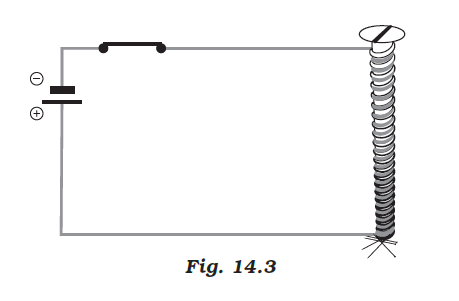
Answer- Questions-
- How does the electric current affect the iron nail and its ability to attract pins?
This question explores the concept of electromagnetism and how passing an electric current through the coil transforms the iron nail into an electromagnet. - What would happen if the number of turns in the wire coil around the nail is increased or decreased?
This investigates the relationship between the number of coil turns and the strength of the electromagnetic field produced, affecting the nail’s magnetic properties. - Will the iron nail continue to attract the pins when the current is switched off?
This question delves into whether the magnetism in the nail is temporary (only while current flows) or permanent, and the nature of electromagnetism in this context.
18. Paheli took a wire of length 10 cm. Boojho took a wire of 5 cm of the same material and thickness. Both of them connected the wires as shown in the circuit given in Figure 14.4. The current flowing in both the circuits is the same.
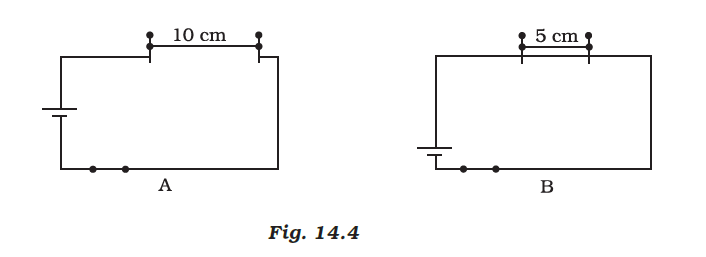
(i) Will the heat produced in both the cases be equal? Explain.
Answer- No, the heat produced in both cases will not be equal. The heat produced in an electrical wire is related to its resistance, which in turn is affected by the length of the wire. A longer wire, like the 10 cm wire used by Paheli, has more resistance than a shorter wire of the same material and thickness, like the 5 cm wire used by Boojho. As a result, Paheli’s longer wire will produce more heat when the same amount of current passes through it compared to Boojho’s shorter wire.
(ii) Will the heat produced be the same if the wires taken by them are of equal lengths but of different thickness? Explain.
Answer- No, the heat produced will not be the same if the wires are of equal lengths but different thicknesses. The resistance of a wire also depends on its thickness or cross-sectional area. A thinner wire has higher resistance compared to a thicker wire of the same length and material. Consequently, the wire with a smaller thickness (higher resistance) will produce more heat when an electric current flows through it, as compared to the thicker wire with lower resistance.
19. How does the magnetic effect of electric current help in the working of an electric bell? Explain with the help of a diagram.
Answer- In an electric bell, the magnetic effect of electric current is used to create motion which rings the bell. Here’s how it works-
- An electric bell has an electromagnet – a coil of wire that becomes magnetic when electricity passes through it.
- When the switch of the bell is turned on, electric current flows through the electromagnet, making it magnetic.
- This electromagnet attracts a piece of iron attached to a metal strip (called an armature). Attached to this strip is a hammer that hits the bell to make a ringing sound.
- When the electromagnet pulls the armature, it also breaks the circuit, stopping the current and making the electromagnet lose its magnetism.
- The armature then goes back to its original position, closing the circuit again, which makes the electromagnet pull the armature back. This cycle repeats rapidly, making the bell ring continuously.
Diagram-
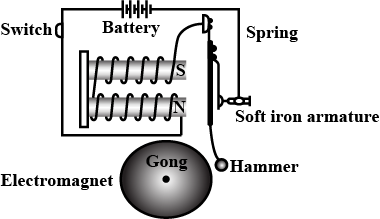
20. Draw the symbols of the following circuit components.
Answer- (i) Electric cell- The symbol for an electric cell consists of two lines of unequal length. The longer line represents the positive terminal, and the shorter line represents the negative terminal.
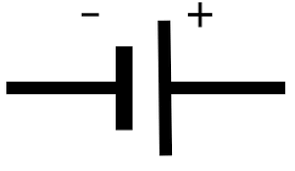
(ii) Switch in off position- The symbol for a switch in the off position is shown as a line with a break in it, indicating that the circuit is open and no current can flow.

(iii) Electric bulb- The symbol for an electric bulb is a circle with a cross inside it, representing the filament of the bulb.
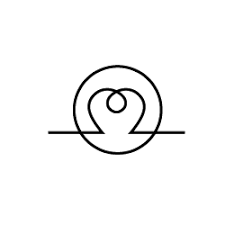
(iv) Battery- The symbol for a battery is a combination of several short and long lines arranged alternately. It represents multiple cells in a series where the longer lines are the positive terminals and the shorter lines are the negative terminals.
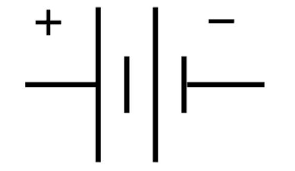
Also Check- Batteries- The Powerhouses of Everyday Life – A Guide for Upper Primary Students
Also Check- Electromagnets- A Guide for Upper Primary Students
Also Check- Electric Bell Diagram for Class 7 Science
Also Check- Chapter 14- Electric Current and Its Effects-Class 7 science- Question and Answers
Also Check- Chapter 14- Electric Current and Its Effects–Class 7 science- Question and Answer -(Solved MCQs)
Also Check- NCERT Solutions for Class 7 Science Chapter 14- Electric Current and its Effects
Also Check- Class 7 science -Chapter 14 – Electric Current and Its Effects- Complete Notes
